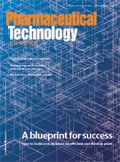Trends in mass spectrometry
Pharmaceutical Technology Europe
To fully optimize MS performance, corresponding enhancements are required in the other functional components of the integrated LC/MS platform.
Mass spectrometry (MS) is seen by many as a primary detection technology in drug discovery and development as well as in pharmaceutical QA/QC. Molecular mass is arguably the most broadly discriminative analytical parameter. Conjoined with LC retention time, it provides a distinctive signature for each analyte across the broad sweep of molecular entities. In addition, the ability to measure relative abundance also makes MS a first-order tool for quantification. Despite its large and long-standing contributions, MS technology has not fully met modern pharma application needs.

In target discovery, for the selectivity necessary to discern individual molecular signatures, mass accuracy is key. For picking up low-abundance biomarkers indicative of a pathway or metabolic response an ultra-low level of detection (LOD) is desired. This has only been available from very high priced MS.
In drug discovery, the focus has traditionally been on speed and throughput. A brute force approach to the workflow has made it possible to generate and then rapidly evaluate large numbers of molecular candidates for potency against multiple screens. Over time, however, this approach has yielded diminishing returns and increasing operational costs.
For QA/QC, with its massive and increasing processing load, throughput will always be issue number one. Add to that the need for better sensitivity, robust and repeatable performance, and ease-of-use.
A new generation of MS tools
New MS solutions to the challenges described above are now emerging. They are derived from key advances such as:
- 2 ppm mass accuracy LC/MS TOF
- multimode source with simultaneous ESI and APCI ion generation
- ultra sensitive next generation triple quad MS/MS
- fundamental advances in data mining, quantification and reporting software.
These advances have given rise to new levels of performance, ease-of-use and throughput for many applications. In some cases, they are facilitating entirely new work flows.
Examples of such application shifts include pre-empting time consuming biomarker identification analyses with profiling-based methodologies in an effort to reduce the number of required IDs to be preformed. Such proteomic and metabolomic profiling techniques are the direct result of new high mass accuracy LC/MS TOF instrumentation that can give uniqueness to literally thousands of analytes in a single analysis. Mass accuracies in the 1–2 ppm level that extend over a wide analyte concentration are the result of sophisticated calibration and reference mass correction algorithms that have been realized via simple software control. When the application centres on the small or large molecule confirmation, the same features result in a completely automated "walk up analysis", wherein a user places samples in the instrument's autosampler, selects the method, initiates the run command, and in due course receives the results in a preselected report format.
Multimode ionization source technology has improved many screening techniques as well as applications in QA/QC. Multimode ionization gives greater universality by simultaneously generating ions by both ESI and APCI processes under a very broad range of separation flow-rate conditions. These advances eliminate the need for replicate analysis, resulting in higher throughput.
To address the need for cost-effective performance, ruggedness and ease-of-use, there are new generation instruments such as the triple quadrupole MS with femtogram-level sensitivity. Intended for a variety of pharma analytical applications, these machines are exceptionally reliable and are supported by easy-to-learn operating and end user customizable reporting software. Innovations of this sort are particularly welcome in quantification of drug candidates from early in vitro studies through clinical trials where the requirement for high throughput remains unabated and where challenges such as sample preparation, formulation complexity and detection limits are becoming more demanding.
New developments complete the picture
To fully optimize MS performance, corresponding enhancements are required in the other functional components of the integrated LC/MS platform. Here too, there are exciting developments pushing the performance envelope. New rapid-resolution HPLC systems capable of order-of-magnitude increases in throughput have recently been introduced. On another technology front, the microfluidic HPLC chip is revolutionizing column chromatography. The chips are designed to integrate with and maximize the entire continuum of LC/MS performance. Benefits include easier operation, greater application flexibility, increased uptime and lower operational costs.
Ultrasensitive and diverse MS technology, high throughput, rapid-resolution LC, microfluidic chips and new informatics — these are the key components of emerging instrument platforms that will support the growing suite of analytical applications across the pharma enterprise.
Taia Ergueta is general manager for proteomics, metabolomics and LC/MS at Agilent Technologies, USA.

Drug Solutions Podcast: A Closer Look at mRNA in Oncology and Vaccines
April 30th 2024In this episode fo the Drug Solutions Podcast, etherna’s vice-president of Technology and Innovation, Stefaan De Koker, discusses the merits and challenges of using mRNA as the foundation for therapeutics in oncology as well as for vaccines.
Drug Solutions Podcast: Gliding Through the Ins and Outs of the Pharma Supply Chain
November 14th 2023In this episode of the Drug Solutions podcast, Jill Murphy, former editor, speaks with Bourji Mourad, partnership director at ThermoSafe, about the supply chain in the pharmaceutical industry, specifically related to packaging, pharma air freight, and the pressure on suppliers with post-COVID-19 changes on delivery.